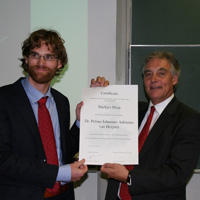On Friday October 8, 2010, there was a Stieltjes afternoon at Leiden University organized by the Thomas Stieltjes Institute for Mathematics.
 Fred Bakker (l), Michiel Zonnevylle, mayor of Leiderdorp (r) At the end of the afternoon Fred Bakker, secretary of the Stieltjes Institute, was appointed "Ridder in de Orde van Oranje-Nassau" for all his work in Mathematics and in the Stieltjes Institute.
PROGRAMME
13:15 -- 13:45
Welcome (coffee and tea)
 Peter van Heijster (l) and Paul van der Heijden (r)
Presentation of the Stieltjes Ph.D.-student prize 2009
by Prof.mr. Paul van der Heijden, Rector Magnificus and Chairman Leiden University.
14:00 -- 14:30
dr. Peter van Heijster (Brown University, USA), winner Stieltjes prize 2009
"Planar radial spots in a 3-component system"
14:45 --15:00
Prof.dr. Frans Oort (UU),
"John Tate: as a mathematician, as a person"
 Jaap Top
Prof.dr. Jaap Top (RUG),
"Tate and elliptic curves"
15:30 -- 16:00
Break
 Frans Oort
Prof.dr. Frans Oort (UU),
"Tate modules and arithmetic geometry"
 Peter Stevenhagen
"Elliptic curves and cryptography"
17:00 -- 18:00
DRINKS
Location:
De Sitterzaal, Oortgebouw, Leiden University
Niels Bohrweg 2
2333 CA Leiden
Registration
If you would like to attend the Stieltjes afternoon you can send an e-mail to Tineke Bakker.
One research school
On January 1, 2011, the three research schools EIDMA, MRI and Stieltjes Institute will merge into one national research school mathematics.
ABSTRACTS
dr. Peter van Heijster (Brown University, USA), winner Stieltjes prize 2009
"Planar radial spots in a 3-component system"
It is a well-accepted belief that the increase of the number of components in a reaction-diusion equation increases the complexity of the dynamics of the equation. In this presentation, we analyze the existence and stability of stationary localized structures of a certain two-dimensional three-component FitzHugh-Nagumo system. In particular, we report on results on the most unstable eigenvalues that decide through which type of instability the stationary structures become unstable. The underlying model was proposed in the nineties to describe, on a phenomenological level, the behavior of gas-discharge systems. Numerical simulations suggest that the third component is necessary to stabilize traveling spot solutions as these solutions are unstable for its two-component analogue.
Frans Oort (Universiteit Utrecht)
John Tate: as a mathematician, as a person
We will illustrate Tate's pioneering ideas in creating
new tools, his modesty and his wit.
Jaap Top (Rijksuniversiteit Groningen)
Tate and elliptic curves
Tate's name is attached to a lot of notions and statements
such as Tate-curve, Tate-cohomology, Tate-algorithm, Tate-pairing,
(Barsotti-)Tate-group, Tate-module, Tate-conjectures, Tate-spectrum,
(Lubin-)Tate formal group, (Sato-)Tate-equidistribution, and more.
In this talk aimed at nonexperts we discuss some of Tate's influence
on the theory of elliptic curves. Several of the notions mentioned
above are related to this.
Frans Oort (Universiteit Utrecht)
Tate modules in arithmetic geometry
Classical tools like abelian integrals and lattices are
of great use in complex geometry. However, in number-theoretic
situations a new tool had to be invented. Tate constructed Tate
modules, a very natural concept which started a great break-through
in geometric aspects of number theory. We will show, on the one hand,
how lattices and complex structures give strong results in complex
geometry. These results have their natural analogues, on the other
hand, in Tate modules and conjectures and results in arithmetic
geometry. Tate showed the first important case: his conjecture for
abelian varieties over finite fields. These ideas were later
expanded by Faltings, and used in the proof of Wiles of FLT
(although we will not discuss these). We will try to make both the
classical analytic and the modern arithmetic ideas and analogies
understandable for anyone.
Peter Stevenhagen (Universiteit Leiden)
Elliptic curves and cryptography
Tate's work is usually classified as being part of pure mathematics, and rightly so. The last few decades have however shown that there is no intrinsic distinction between pure and applied mathematics, and I will illustrate this by discussing the relevance of some of Tate's ideas in modern cryptography.
Organization Committee:
Fred Bakker
Frank den Hollander
Hendrik Lenstra
Peter Stevenhagen
|





